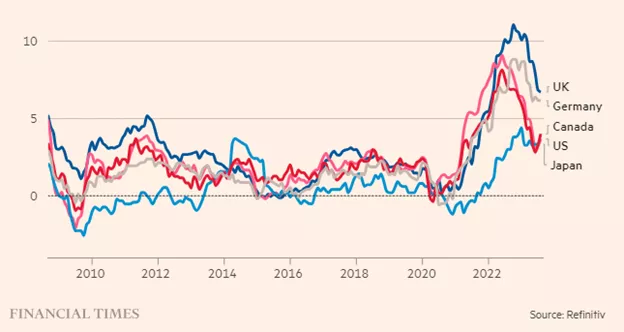If Global Monetary Tightening Is Over, What Lies Ahead?

Image Source: Pixabay
As if, on cue, major central bankers decided against raising rates this month, but at the same time warned investors not to rule out rate increases in the very near future. This is an example, of “on the one hand, and on the other hand”, a phrase often applied to economists when discussing policy directions. Central banks in the US, UK, Japan, Switzerland, and Canada decided to keep rates on hold, a pause that gave many investors temporary relief. But, almost in the same breath, the bankers held out the prospects for continued rate increases, should inflation pick up. Bankers acknowledged that they remain on guard, despite the evidence that inflation continues to fall in most Western nations.
There seem to be two broad-based schools of thought. One approach concerns the fact that inflation has definitely reversed course, topping out in the high single-digits and now hovering around the 3-4% mark. Although the 2% target has not been reached, directionally, inflation is on the decline. Threats continue to exist, however, as energy prices are at the mercy of OPEC and food prices continue to be subject to supply disruptions from climate change. Overall, the goods-producing industries continue to see prices weakening, and the deflationary forces out of China have yet to be felt. This school anticipates rate cuts starting as early as mid-2024. However, the Fed has made it clear that its decision to hold the line should not be interpreted as a sign that it has reached the end of the road on monetary tightening. A similar admonition came from the Bank of Canada and the ECB. The bankers maintain their option to raise rates should inflation remain stubbornly above 2%.
Figure 1 Annual Change in the CPI

The second school of thought is that we are in a prolonged period in which rates will be “higher for longer”, a familiar mantra among economists. This approach is widely adopted in which rates remain at these current levels, forcing investors and consumers to adjust indefinitely to a world featuring higher nominal and real rates of interest---- put differently, there is no going back to rates preceding this current rate cycle. Monetary policymakers have largely dismissed talk about the possibility of rate cuts and continue to argue that more work needs to be done to tame inflation.
Have rates peaked? Should this pause be the precursor to rate cuts? Or, is the current level to be the new normal?
Economic activity everywhere has weakened. Starting with international trade, purchasing managers’ indices tracking new export orders indicate a sharp contraction across the US, the Eurozone, and the UK. The boom in the demand for goods during the pandemic has given way to a decline in export volumes in the US, China, and the Eurozone. (Trade falls). Domestically, US data has been clearly mixed in which residential construction and sales have been negatively affected, now that mortgage rates are at 7%. The decline in commercial real estate values has now been identified as a major threat to regional banks in the US. Canada actually experienced a contraction in GDP in the second quarter, led by the decline in the housing market; the outlook remains very cautious regarding a return to growth. Many economists are questioning whether there is a need to maintain such an aggressive posture, given that financial conditions are tightening. The money supply is shrinking as central banks exercise quantitative tightening measures along with commercial banks curtailing their loan book.
In sum, evidence is piling in to support a cessation of rate hikes. However, the central banks continue to warn that they may not be finished, leaving all of us in a twilight zone.
More By This Author:
An Old-Fashion Credit Crunch Is In The Making As Money Supply ContractsCanadian Banks Expecting A Worsening Economy
Waiting For The Anticipated Recession Is Very Tiresome



